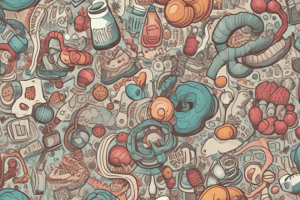Podcast
Questions and Answers
What is the primary function of carbohydrates in the body?
What is the primary function of carbohydrates in the body?
- Major fuel source in cells (correct)
- Transport of nutrients
- Structural support in cells
- Hormonal regulation
What is the reason humans cannot obtain glucose from cellulose?
What is the reason humans cannot obtain glucose from cellulose?
- Amylase can only act on alpha glycosidic linkages.
- Cellulose does not contain glucose.
- Cellulose is not consumed in a typical human diet.
- We lack the enzyme to break down the B glycosidic linkage in cellulose. (correct)
Which of the following represents the general formula for monosaccharides?
Which of the following represents the general formula for monosaccharides?
- C_nH_2nO_n (correct)
- C_nH_2O_{n-1}
- C_nH_2O_n
- C_nH_nO_n
Which enzyme allows the breakdown of starch to produce glucose?
Which enzyme allows the breakdown of starch to produce glucose?
How do monosaccharides primarily exist in solution, instead of their linear form?
How do monosaccharides primarily exist in solution, instead of their linear form?
Why might a human diet still benefit from consuming vegetables?
Why might a human diet still benefit from consuming vegetables?
What type of bond is formed between two monosaccharides to create a disaccharide?
What type of bond is formed between two monosaccharides to create a disaccharide?
What type of linkage is formed during the condensation reaction between galactose and α-glucose to form lactose?
What type of linkage is formed during the condensation reaction between galactose and α-glucose to form lactose?
Which functional groups are common in carbohydrates?
Which functional groups are common in carbohydrates?
What is the main component in the stability of plant cell walls?
What is the main component in the stability of plant cell walls?
What type of glycosidic linkage is found between two α-glucose molecules?
What type of glycosidic linkage is found between two α-glucose molecules?
What is the process used to separate two monosaccharides by adding water?
What is the process used to separate two monosaccharides by adding water?
Which of the following disaccharides is composed of glucose and fructose?
Which of the following disaccharides is composed of glucose and fructose?
What is the primary function of cellulose in plants?
What is the primary function of cellulose in plants?
What type of glycosidic linkage is found in cellulose?
What type of glycosidic linkage is found in cellulose?
Which polysaccharide is primarily used for energy storage in animals?
Which polysaccharide is primarily used for energy storage in animals?
How do starch and cellulose differ in their glucose linkages?
How do starch and cellulose differ in their glucose linkages?
Which of the following is NOT a characteristic of glycogen?
Which of the following is NOT a characteristic of glycogen?
What type of bond is formed between two monosaccharides?
What type of bond is formed between two monosaccharides?
Why can humans digest potatoes but not grass?
Why can humans digest potatoes but not grass?
Study Notes
Macromolecules: Carbohydrates
- Macromolecules are large molecules composed of smaller repeating units called monomers linked together by covalent bonds.
- Polymers are long chains of monomers.
Monosaccharides
- Monosaccharides are simple sugars, the monomers of carbohydrates.
- Formula: General formula is (CH2O)n, where n is usually between 3 and 7.
- Key Examples: Glucose, galactose, and fructose.
- Functional Groups: Contain multiple hydroxyl (-OH) groups and one carbonyl (C=O) group, making them soluble in water.
- Ring Structures: Monosaccharides exist in both linear and ring forms, with the ring form being more stable in solution.
Disaccharides
- Disaccharides consist of two monosaccharides joined by a glycosidic linkage.
- Formation: Created by dehydration synthesis (removal of water).
- Types of Glycosidic Linkages:
- α-glycosidic linkage: Found in starch, bond between two α-glucose molecules.
- β-glycosidic linkage: Found in cellulose, bond between two β-glucose molecules.
- Important Examples:
- Sucrose: Glucose + Fructose
- Maltose: Glucose + Glucose
- Lactose: Glucose + Galactose
Polysaccharides
- Polysaccharides are long chains of monosaccharides linked together by glycosidic bonds.
- Formation: Many monosaccharides (~100-1000 or more) joined together.
- Important Examples:
- Starch: Plant energy storage, composed of amylose (linear) and amylopectin (branched), α-glycosidic linkages.
- Cellulose: Plant structural support, β-glycosidic linkages.
- Glycogen: Animal energy storage, highly branched, α-glycosidic linkages.
- Differences:
- Structure: Straight chains vs. branched chains.
- Function: Storage vs. structural support.
- Glycosidic Linkages: α vs. β.
Why Can't We Digest Cellulose?
- We lack the enzymes needed to break down the β-glycosidic linkages in cellulose.
- We possess the enzyme amylase to break down the α-glycosidic linkages in starch, allowing us to obtain energy from it.
- Cellulose provides fiber in our diet, supporting digestive health.
Studying That Suits You
Use AI to generate personalized quizzes and flashcards to suit your learning preferences.
Related Documents
Description
This quiz covers essential topics related to carbohydrates, including their structure and types. It explores monosaccharides, disaccharides, and their chemical properties, focusing on functional groups and glycosidic linkages. Test your knowledge of these fundamental macromolecules and their roles in biology.




